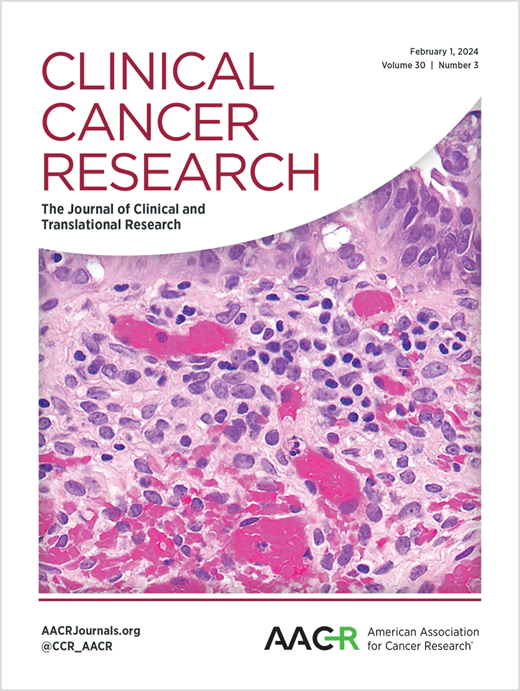大规模多组学分析确定平滑肌肉瘤亚型的解剖差异和免疫原性潜力
IF 10
1区 医学
Q1 ONCOLOGY
引用次数: 0
摘要
目的:采用综合分子谱分析方法确定平滑肌肉瘤(LMS)解剖亚型的基因组和免疫景观,这些亚型尚未完全表征。设计:1115个LMS样本,分为子宫(uLMS)、腹膜后(rpLMS)或其他(oLMS),进行DNA/RNA测序(Caris Life Sciences)。基因组/转录组谱在不同亚型之间进行比较。免疫谱分析与黑色素瘤(n=1255)进行比较,黑色素瘤是一种免疫原性肿瘤。保险索赔数据用于推断LMS患者使用免疫检查点抑制剂(ICI)的真实结果。结果:uLMS (n=701)与rpLMS (n=166)和oLMS (n=248)在分子上存在差异。RB1突变和MAP2K4拷贝数扩增在非ulms中更为常见。MED12突变几乎是uLMS所独有的。传统的ICI反应生物标志物(即PD-L1)不因解剖部位而异。非ulms表现出免疫相关基因集的上调,包括干扰素和炎症反应途径,以及更高的免疫细胞浸润,特别是CD8+ T细胞和B细胞(增加2倍,p<0.0001)。与黑色素瘤相比,LMS具有较低的免疫细胞丰度和t细胞炎症评分(TIS),尽管11%的oLMS样本具有较高的TIS评分。在现实世界的队列中(n=138), 29%接受ICI的LMS患者治疗了6个月,这表明潜在的临床益处。结论:综合分析表明,uLMS是一种分子上不同于非uLMS的疾病。虽然传统的ICI反应生物标志物在解剖亚型中相似,但与非uLMS相比,uLMS具有免疫冷性。在一些肿瘤中,ICI反应性信号,如高TIS和免疫细胞丰度,表明有必要进一步研究LMS的免疫疗法。本文章由计算机程序翻译,如有差异,请以英文原文为准。
Large scale multi-omic analysis identifies anatomic differences and immunogenic potential in subtypes of leiomyosarcoma
Purpose: Comprehensive molecular profiling was used to define the genomic and immune landscapes of leiomyosarcomas (LMS) by anatomic subtype, which have not been completely characterized. Design: 1115 LMS samples, categorized into uterine (uLMS), retroperitoneal (rpLMS), or other (oLMS), underwent DNA/RNA sequencing (Caris Life Sciences). Genomic/transcriptomic profiles were compared across subtypes. Immune profiling was compared to melanoma (n=1255), an immunogenic tumor. Insurance claims data were used to infer real-world outcomes with immune checkpoint inhibitors (ICI) in LMS. Results: uLMS (n=701) were molecularly distinct from rpLMS (n=166) and oLMS (n=248). RB1 mutations and MAP2K4 copy number amplification were more common in non-uLMS. MED12 mutations were almost exclusive to uLMS. Traditional ICI response biomarkers (i.e. PD-L1) didn’t vary by anatomic site. Non-uLMS demonstrated upregulated immune-related gene sets, including interferon and inflammatory response pathways, and higher immune cell infiltration, especially CD8+ T cells and B cells (>2-fold increase, p<0.0001). LMS had lower immune cell abundance and T-cell inflamed scores (TIS) compared to melanoma, though 11% of oLMS samples had high TIS scores. In a real-world cohort (n=138), 29% of LMS patients receiving ICI were treated >6 months, indicating potential clinical benefit. Conclusion: Comprehensive profiling suggested that uLMS represents a molecularly distinct disease from non-uLMS. While traditional ICI response biomarkers were similar across anatomic subtypes, uLMS were immune cold compared to non-uLMS. Signals for ICI responsiveness, such as high TIS and immune cell abundance, in some tumors suggest that further research into immunotherapies for LMS is warranted.
求助全文
通过发布文献求助,成功后即可免费获取论文全文。
去求助
来源期刊

Clinical Cancer Research
医学-肿瘤学
CiteScore
20.10
自引率
1.70%
发文量
1207
审稿时长
2.1 months
期刊介绍:
Clinical Cancer Research is a journal focusing on groundbreaking research in cancer, specifically in the areas where the laboratory and the clinic intersect. Our primary interest lies in clinical trials that investigate novel treatments, accompanied by research on pharmacology, molecular alterations, and biomarkers that can predict response or resistance to these treatments. Furthermore, we prioritize laboratory and animal studies that explore new drugs and targeted agents with the potential to advance to clinical trials. We also encourage research on targetable mechanisms of cancer development, progression, and metastasis.
 求助内容:
求助内容: 应助结果提醒方式:
应助结果提醒方式:


